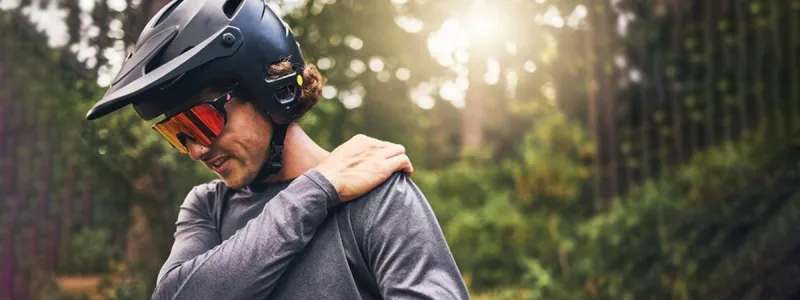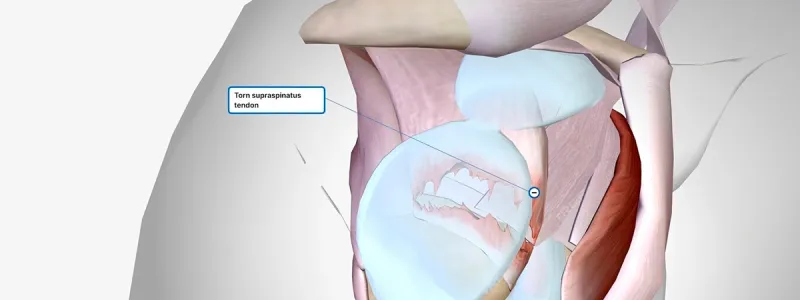A high-speed impact can lead to ligament separation, known as shoulder separation, a common injury in mountain bikers. Shoulder pain arises around the shoulder joint, where four muscle tendons connect to form the rotator cuff.These tendons facilitate shoulder movement and stabilize the upper arm bone.
Mountain bike shoulder pain indicates excessive load due to insufficient endurance or strength. By stopping the ride, the shoulders will be relieved of their burden, allowing them to get some rest. Persisting may also result in serious injury.
In this blog post, we’ll explore the various common shoulder injuries from mountain biking, their causes, symptoms, prevention tips, and treatment options. By understanding the anatomy and function of your shoulder joint and rotator cuff, you’ll be better equipped to enjoy your mountain biking adventure safely.
Shoulder Pain From Mountain Biking: 3 Causes

Understanding mountain biking shoulder injuries can help bikers prevent and manage these injuries. In this blog post, we will discuss three common shoulder injuries experienced by mountain bikers, including shoulder dislocations, shoulder separations, and clavicle fractures.
Shoulder Dislocations: Causes, Symptoms, and Treatment
The shoulder socket pops out of the upper arm bone. This type of injury is common in mountain biking due to the twisting, jarring, and sudden impacts bikers experience on the trails. Some causes of shoulder dislocations include:
- Falling off the bike and landing on the shoulder.
- Overuse of the shoulder during biking.
- Poor posture and body mechanics while biking.
Symptoms of shoulder dislocations include:
- Severe pain and spasms in the shoulder.
- Limited shoulder mobility.
- Swelling and bruising.
- Numbness or tingling in the arm and hand.
Immediate medical attention is necessary to reduce the shoulder dislocation and manage the injury. Treatment options may include:
- Closed reduction, which involves resetting the shoulder bone manually.
- Immobilization of the affected arm in a sling.
- Physical therapy to restore shoulder strength and flexibility.
Shoulder Separations: Types, Signs, and Medical Interventions
Shoulder separations refer to injuries that affect the acromioclavicular (AC) joint between the collarbone and shoulder blade. Shoulder separation injuries are sometimes caused by falls from bikes, collisions, or excessive shoulder use. The types of shoulder separations include:
- Type I: Mild sprain of the AC ligament.
- Type II: AC ligament tear and slight displacement of the collarbone.
- Type III: Complete AC ligament tear and significant collarbone displacement.
Signs of shoulder separations may include:
- Shoulder pain.
- Swelling and bruising.
- Shoulder stiffness.
- Limited mobility and range of motion.
Medical intervention for shoulder separations may depend on the type and severity of the injury. Conservative treatment options include rest, ice, compression, and elevation (RICE therapy). Severe separations may require surgical intervention.
Clavicle Fractures: Diagnosis, Treatment, and Long-term Impacts
Clavicle fractures are breaks in the neck bone connected to the breastbone. This type of injury often occurs due to falls or direct impact on the shoulder during mountain biking. Some signs of clavicle fractures include:
- Shoulder pain and swelling.
- Bruising and tenderness.
- A visible bump or deformity.
- Limited shoulder mobility.
Diagnosis of clavicle fractures may require X-rays or other imaging tests. Treatment options may include:
- The affected arm is immobilized with a sling or brace.
- Pain management with medication.
- Flexibility and strength training for shoulders.
The long-term impacts of clavicle fractures may include:
- Chronic shoulder pain and stiffness.
- Reduced range of motion and mobility.
- Impaired ability to perform daily activities and sports.
Shoulder Pain From Cycling: Anatomy

Shoulder pain while riding a bike in mountain biking can stem from several factors, such as regular strain, overuse, or sudden impact. We will explore the intricacies of the shoulder joint and the rotator cuff and how they are impacted during mountain biking.
The Shoulder Joint and Its Role in Mountain Biking
It has a wide range of motion, making it a crucial component of many sports, including mountain biking. Here’s how the shoulder joint plays a role in mountain biking:
- Steering: The shoulder joint helps turn the handlebars, which is essential for navigating through tight trails and steep descents.
- Absorbing Shock: The shoulder joint absorbs the shock from obstacles, such as rocks, roots, and drops, reducing the impact on the rest of the body.
- Balancing: The shoulder joint aids in maintaining balance while negotiating tricky terrain.
- Weight-bearing: The shoulders bear some of the upper body’s weight while cycling, which is especially important during uphill climbs. The weight of the rider affects calorie burn.
Stability and Movement of The Rotator Cuff
The rotator cuff is a group of four tendons and muscles that connect the arm bone to the shoulder blade, providing strength and stability to the shoulder joint. Here’s how the rotator cuff aids in shoulder stability and movement during mountain biking:
- Stabilization: The rotator cuff muscles keep the shoulder joint in place during movements, reducing the risk of dislocation.
- Arm movement: The rotator cuff muscles enable the arm to move in different directions, including lifting, rotating, and reaching.
- Shock absorption: The rotator cuff helps in absorbing shock to prevent injuries.
How Shoulder Injuries Occur During Mountain Biking
Shoulder injuries are common among mountain bikers due to the nature of the sport, which involves navigating uneven terrains, high speeds, and unexpected obstacles. Here are some of the common shoulder injuries incurred during mountain biking:
- Rotator cuff tears: The rotator cuff muscles can tear from overuse or sudden impact.
- Shoulder dislocations: The ball and socket joint of the shoulder can become dislocated from the sheer force of a fall or collision.
- Shoulder separations: The collarbone can become separated from the shoulder blade pain due to a direct impact or a cycling fall on the shoulder.
- Fractures: The shoulder bones can develop cracks or breaks from a hard fall.
Shoulder Pain From Mountain Biking: Preventing and Treating
Shoulder pain due to bike riding is an all-too-common issue for mountain bikers, and it can leave you out of commission for days or weeks. To help you stay on the trail and avoid painful injuries, we’ve compiled a comprehensive guide to preventing and treating shoulder injuries from mountain biking.
Prevention Tips for Shoulder Injuries on the Trail

Preventing shoulder injuries starts with being mindful of your body and your surroundings on the trail. Here are some tips to help you stay safe:
- Ride within your skill level and avoid risky maneuvers that could put you at risk for shoulder injuries.
- Use proper body positioning on descents, and avoid locking your elbows.
- Properly adjust your bike’s handlebars and brake levers to reduce stress on your shoulders.
- Stay hydrated and take breaks to avoid fatigue, which can increase your risk of injury.
Warm-up and Stretching Techniques for Shoulder Preparedness
Warming up and stretching before hitting the trail can significantly reduce your risk of shoulder injuries. Here are some techniques to try:
- To get your blood flowing, begin with light aerobic exercises like jumping jacks or a brief jog.
- To warm up your shoulder muscles, perform shoulder-specific stretches, such as the doorway stretch.
- Gradually increase the intensity of stretches and warm-ups to avoid injury.
Choosing Appropriate Gear and Maintaining Your Bicycle for Shoulder Safety
Proper gear and bike maintenance can also help prevent shoulder injuries. Here are some tips:
- Choose a bike with appropriate suspension and brakes to reduce shoulder strain.
- Wear protective gear, such as quality shoulder pads and gloves, to protect your shoulders in the event of a fall.
- Maintain your bike’s suspension and brakes to ensure they function correctly and reduce stress on your shoulders.
Treatment Options: Rest, Medication, Physical Therapy, and Surgery
If you experience shoulder pain, seeking treatment to prevent further injury is essential. Here are some standard treatment options:
- Reduce inflammation and pain with rest and ice.
- Over-the-counter or prescription medication to manage pain.
- Physical therapy to improve shoulder strength and flexibility.
- Surgery for severe cases of injury.
Rehabilitation Strategies for Regaining Shoulder Function and Strength
After the initial treatment, rehabilitation can help you fully regain strength and function in your shoulder. Here are some strategies:
- Exercises for stretching and restoring shoulder flexibility.
- Progressive resistance exercises to strengthen the shoulder muscles over time.
- Continued physical therapy or training to maintain strength and prevent future injuries.
Conclusion
Shoulder pain is the quiet enemy of mountain biking enthusiasts; it can sneak up on you, and before you know it, it can cause you significant discomfort and even force you to quit cycling. However, you don’t have to give up your passion for mountain biking just because of shoulder pain.
Taking cautionary measures and following the prevention tips mentioned in this blog post can go a long way in keeping your shoulders healthy and pain-free. Even when symptoms do appear, early intervention and proper treatment can help you recover and regain your full shoulder mobility and strength.
Remember to seek professional help if your shoulder pain worsens, and never ignore its significance. With the right mindset and preparation, you can continue to conquer new challenges on your bike safely without fearing the prospect of injuring your shoulders.
FAQs
Can I Do Mountain Biking After Rotator Cuff Surgery?
Yes, you can do mountain biking after rotator cuff surgery, but the timeline varies based on factors like surgery type and healing progress. Typically, you may start with a stationary bike at 2 weeks, progress to road biking at 5-6 months, and mountain biking at 6-12 months post-surgery. Always consult your doctor or therapist for personalized guidance.
What Is The Cause Of Shoulder Pain After Falling Off The Bike?
Shoulder pain after falling off a bike can result from injuries like a fractured collarbone (clavicle), damage to the shoulder joint (acromioclavicular joint or ACJ), or rotator cuff injury. These injuries are common due to the impact on the shoulder when falling on an outstretched arm or the side of the shoulder. It’s essential to seek medical attention for proper diagnosis and treatment.
Does Cycling Cause Shoulder Pain On One Side?
Yes, cycling can cause shoulder pain on one side. One common reason is poor bike fit at the front end, such as being too stretched out or too low. This can lead to neck and shoulder pain, especially if the position puts strain on one side more than the other.
Does Cycling Cause Shoulder Impingement?
Yes, cycling can lead to shoulder impingement due to the prolonged rides that exert significant pressure on the shoulders, particularly affecting the rotator cuff, a crucial shoulder stabilizer.
Why Is My Upper Arm Pain After Cycling?
Your upper arm pain after cycling may be caused by excessive pressure on your hands. To alleviate this, ensure that when cycling at your functional threshold power or around 85% of your maximum heart rate on flat terrain, your hands bear minimal weight on the handlebars. This can help reduce strain on your upper limbs and alleviate discomfort.
What Causes Shoulder Pain After A Bike Accident?
Shoulder pain after a bike accident can be caused by injuries to the glenohumeral joint, such as labral tears or damage to structures like the rotator cuff. Additionally, impingement and swelling of soft tissues in the shoulder can contribute to the pain.


